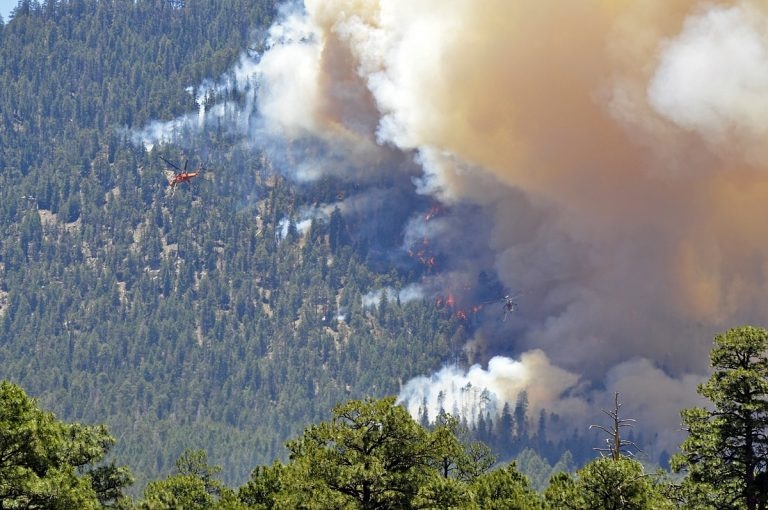Aug 6 2019
When forests are ravaged by wildfires, they not only damage the trees but also destroy a core part of the world’s carbon cycle. Restoring those trees as fast as possible could tip the scale in favor of alleviating extreme climate change.
 Air support flies in to drop fire retardant on a mountain range in Coconino National Forest in 2010. (Photo courtesy of USDA Forest Service, Coconino National Forest.)
Air support flies in to drop fire retardant on a mountain range in Coconino National Forest in 2010. (Photo courtesy of USDA Forest Service, Coconino National Forest.)
Lisa A. McCauley, a spatial analyst at The Nature Conservancy, explains how swift action to thin out vegetation will essentially boost carbon storage in forests by the end of this century. Her recent paper has been published in the Ecological Society of America’s journal Ecological Applications, and she will present the findings at ESA’s 2019 Annual Meeting in Louisville, KY.
With predictions of widespread mortality of western U.S. forests under climate change, our study addresses how large-scale restoration of overly-dense, fire-adapted forests is one of the few tools available to managers that could minimize the adverse effects of climate change and maintain forest cover.
Lisa A. McCauley, Spatial Analyst, The Nature Conservancy
Forests are a crucial carbon sink—a natural sponge that absorbs carbon out of the atmosphere through plant photosynthesis. As carbon dioxide (CO2) emissions from human activities are a significant cause of climate change, forests do humanity a major service by getting rid of a lot of its gaseous waste.
Regrettably, wildfires are more frequent than they used to be. Higher tree density, a warmer, drier climate, and more dry wood for fuel have resulted in an increase in the size, frequency, and severity of wildfires in western U.S. forests. Restoring forests in as soon as possible is important in making successive wildfires are less likely.
The U.S. Forest Service explains that rehabilitation and restoration require many years, and comprises planting trees, restoring habitats, re-establishing native species, and treating for invasive plants. There is a critical need for such restoration in the southwest U.S. to compensate for the carbon cycle.
The Four Forest Restoration Initiative (4FRI) is a solution. The U.S. Forest Service started the 4FRI in 2010 to restore 2.4 million acres (3750 square miles) of national forests in Arizona. The goals of the 4FRI are to re-establish the structure, composition, pattern, and health of fire-adapted (reliant on occasional fires for their lifecycle) ponderosa pine ecosystems; decrease fuels and the hazard of unnaturally extreme wildfires; and provide for plant and wildlife diversity.
Doing so includes a complete suite of restoration projects that are performed by US Forest Service personnel, partners, contractors, and volunteers. Managers of the four forests—the Kaibab, Apache-Sitgreaves, Coconino, and Tonto—are busy in a massive, collaborative initiative with a varied group of stakeholders to investigate the best approaches for restoring the ponderosa pine forests in the region.
One such exploration is a research wherein scientists, including McCauley, use computer simulations to study how the carbon cycle and wildfire severity between the years 2010–2099 would be impacted by varying rates of restoration of about 1500 square miles of forest.
A potential downside to a very speedy restoration plan is that it comprises the thinning out (harvesting) of dense, dry trees—perhaps by controlled burns—to eliminate plants that could serve as potential wildfire fuel. Decrease in overall vegetation could mean that the general carbon uptake and storage of these forests would decline.
The conventional wisdom has been that forest restoration in the western U.S. does not benefit carbon stocks. However, with wildfire size, frequency and severity increasing, we believe that additional research is needed across more forests so that we can better understand the fate of carbon and forest cover, particularly for fire-adapted forests where tree densities exceed historical norms and the risks of climate-induced forest loss are increasing.
Lisa A. McCauley, Spatial Analyst, The Nature Conservancy
Fascinatingly, the simulations reveal that regardless of early decreases in the ecosystem’s stored carbon, a speedy restoration plan boosts total carbon storage by 11–20%, which is about 8–14 million metric tons of carbon by the end of the century. This is equal to the elimination of carbon emissions from 67,000–123,000 passenger vehicles every year until 2100.
By minimizing high-severity fires, accelerated forest thinning can stabilize forest carbon stocks and buy time—decades—to better adapt to the effects of climate change on forest cover.
Lisa A. McCauley, Spatial Analyst, The Nature Conservancy
Restored forests offer other advantages than just better carbon storage in the next century. A restored fire-adapted forest would be less thick, with fewer trees but more diversity, permitting more sunlight to enter the canopy, expanding cover of grass, and encouraging a more diverse understory. The wildfires that do happen would burn at lower severity as ground fires that devour grasses rather than burning canopies that kills trees.
McCauley says this research is exclusive as it is a large, landscape-scale study that employs data from an everyday restoration project—the largest restoration being applied in the U.S. The results are certainly encouraging, representing that restoration is likely to stabilize carbon and the advantages are greater when the restoration pace is quicker.